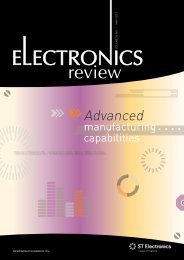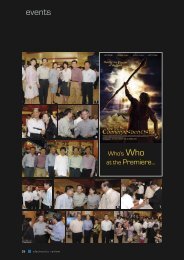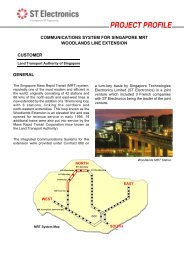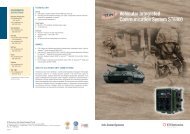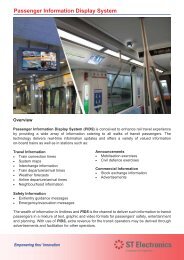<strong>The</strong>y need a connectivity solution thatcan reach every node in their network,monitoring critical, realtime datafrom all their facilities and customersites, and providing instant access toany location to control every aspect oftheir operations.<strong>The</strong> Satellite-enabled Smart GridTo overcome these challenges,utility companies can turn tosatellite-based IP communications.Satellite networks have recentlyadvanced to become two-way, highspeedcommunications systemsthat are built on IP and integrateseamlessly with core communicationsinfrastructure such as fibre andwireless. <strong>The</strong>y reach everywherewithout any geographical constraints.<strong>The</strong>y provide immediate infrastructureiDirect’s IP-based satellite platform can integrate with core comunications tohelp utilities extend broadband connectivity to every location on the smart gridrequirements increased withouthaving to invest in additional hubsystems.Expanding Network CapabilitiesOne of the key applications forsatellite communications on thesmart grid is providing high-speedconnectivity to remote substations.Today, most utility companies connectto these substations to monitorSCADA traffic through narrowbandlinks. But with the development of thesmart grid, utility companies need tosupport broadband applications likevideo surveillance, on-site Voice overIP, and access to corporate networks.<strong>The</strong> iDirect platform allows utilities toreliably handle these new applicationswhile also supporting legacy SCADAnetwork performance andresponse times. WithiDirect, utility companiescan prioritise bandwidth onthe network based on thespecific requirements ofeach application to ensurethat business-criticalSCADA traffic always runs atmaximum reliability, while alsosupporting higher bandwidthapplications.that businesses keep running if andwhen traditional communicationsinfrastructure goes down.With iDirect, utilities can be preparedif a primary network fails. <strong>The</strong>satellite network can seamlessly takeover by providing broadband speedsand an alternative path to handlecritical operations.Another threat to operations isadverse weather conditions, which canlower the strength and reliability of asatellite signal. <strong>The</strong> iDirect platformovercomes this <strong>issue</strong> by automaticallyadjusting signal strength during heavyrains and solar outages to ensure 99.8percent availability.A Smart Choice for the Smart GridSatellite connectivity based on theiDirect platform presents a costeffectivesolution for utility companiesto manage growing operations andintegrate with core communicationsto establish connectivity in remotegeographies. <strong>The</strong>y gain a single,flexible solution for SCADA andbroadband capabilities and a resilient,secure network to protect assetsand improve the reliability of theiroperations.and they enable utilities to manage areliable private network.One company is the leader behindmany of today’s satellite technologyinnovations – iDirect. iDirectdelivers the most cost-effective,flexible, reliable and secure satellitetechnology infrastructure forconnecting critical assets in utilityfacilities and in any environment.<strong>The</strong> iDirect platform is engineeredto establish global satellite networkaccess at a minimal cost. It is anall-Internet Protocol (IP) system thatincludes satellite hubs, line cards,routers and network managementtechnology. Utility companies caneasily scale their network as newsites are added and bandwidthExtending Network ReachAnother smart grid connectivitychallenge is extending AdvancedMetering Infrastructure to remoteareas. Often, utility companies do nothave a cost-effective way to collectmeter data from dispersed and thinlypopulated neighborhoods and sendthis information across their corenetwork.iDirect changes that. Utilitycompanies can backhaul meter datafrom remote concentrator sites and,through a satellite link, deliver itdirectly to their operations centre.Keeping Operations OnlineMaintaining connectivity is imperativeto avoid costly downtime and lossof information. Satellite can ensureTo see how iDirect’s IP-based satelliteplatform can integrate with corecommunications to help utilities extendbroadband connectivity to every location onthe smart grid, please visit http://idirect.net/Applications/Energy-and-Utilities/Energy-Video.aspxAbout the writer:Michel Zimet is Director of Vertical Marketingfor Energy and Utilities at iDirect. Zimethas worked in the telecommunicationsand network industry for over 20 years. Hejoined iDirect in 2004 as Senior Director,Channel Development, where he led a globalteam of channel development managers(Americas, EMEA and Asia Pacific regions)in the implementation and execution ofall elements of iDirect’s channel partnerdevelopment strategy and programs. Since2009, Zimet has been responsible for leadingthe company’s marketing and businessdevelopment efforts within the Energy andUtilities vertical.DECEMBER 2010 29
A P P L I C A T I O NN O T E SAutomatic Meter Reading andAdvanced Metering InfrastructureAutomatic Meter Reading (AMR)developed by <strong>ST</strong> <strong>Electronics</strong> (Info-Comm Systems) deploys the latesttechnology to automatically collectdata from water, electricity or gasmeters and transfers the data toa central database for billing andanalysis. This solution helps reducefield trips required to collect dataand provides utility users with bettercontrol of their electricity and gasusage, and water consumption.Radio Frequency AMR<strong>ST</strong> <strong>Electronics</strong>’ AMR operation isbased on Radio Frequency (RF) andis available in various forms to suitdifferent operational requirements.<strong>The</strong> more common types are thehandheld, mobile, and fixed networkbasedtypes of AMR. <strong>The</strong>re are alsotwo-way and one-way RF systems thatcan use licensed and unlicensed RFbands.For the one-way “bubble-up” orcontinuous broadcasting type ofsystem, the transmitter broadcastsreadings continuously every fewseconds. This means the readingdevice can be a receiver only, and themeter AMR device a transmitter only.Data goes one-way, from the meterAMR transmitter to the meter readingreceiver.In a two-way or “wake up” system, aradio transceiver sends a signal to aparticular transmitter serial number,waking it up from a dormant state totransmit the data. <strong>The</strong> meter-attachedtransceiver and the reader transceiverboth send and receive radio signalsand data.<strong>The</strong>re are also hybrid systems thatcombine the one-way and twowaytechnologies, using one-waycommunication for reading and twowaycommunication for programmingfunctions.RF-based meter reading usuallyeliminates the need for the meterreader to enter the property or home,or to locate and open an undergroundmeter pit. <strong>The</strong> utility agency enjoyscost efficiency through increasedspeed of reading, lower liability risksfrom entry into private properties,and also benefit from fewer missedreadings due to inaccessibility tometers.Fixed NetworkFixed Network AMR deploys a networkthat is permanently installed formeter reading. Through a seriesof antennas, towers, collectors,repeaters, or other permanentlyinstalled infrastructure, meterreadingdata is automaticallytransmitted through AMR-capablemeters to a central computer withoutthe need for personnel on the field.<strong>The</strong>re are several types of networktopologies that are used to transmitthe meter data back to the centralcomputer. Utility agencies are ableto analyse the data to detect leakage,tampering and other abnormalitiesas the data is provided on a realtime,or near realtime basis. <strong>The</strong> FixedArea Network-based AMR uses thelatest technology in mesh networkswhere the meters act as repeaters totransmit data to nearby meters until itreaches the main data collector.Advanced Metering InfrastructureWith the technological developmentof Fixed Area Network-based AMRs,a new concept known as “AdvancedMetering Infrastructure” (AMI)was introduced. AMI combinescommunication networks with data(time-of-use and rate-of-usage)from smart meters for water orenergy usage profiling, time-of-usebilling, demand forecasting, demandresponse, rate-of-flow recording, leakdetection, flow monitoring, water andenergy conservation enforcement andremote shutoff. AMI is a new termcoined to represent the networkingtechnology of fixed network metersystems that go beyond AMR intoremote utility management. <strong>The</strong>meters in an AMI system are oftenreferred to as smart meters since theyoften use the collected data based onprogrammed logic.30 ELECTRONICS REVIEW


![The complete issue [ 36 pages | 2.38MB ] - ST Electronics](https://img.yumpu.com/41667250/29/500x640/the-complete-issue-36-pages-238mb-st-electronics.jpg)
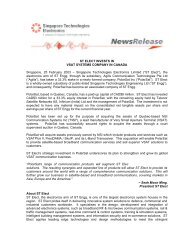
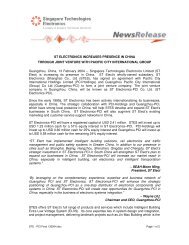
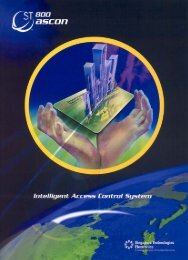

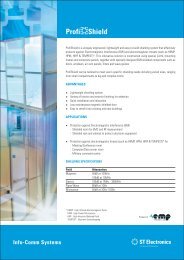


![The complete issue [ 32 pages | 2.43 MB ] - ST Electronics](https://img.yumpu.com/47270333/1/184x260/the-complete-issue-32-pages-243-mb-st-electronics.jpg?quality=85)
